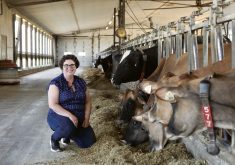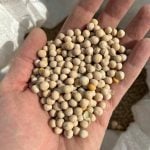Whole-farm margin insurance has been available through Agristability since the Growing Forward programs were first launched. However, the program was plagued with complexity, its reputation fell, and five years ago it was trimmed significantly.
Yet farm risk is on the way up with rising input costs, higher debt levels, and volaltile weather and prices.
Now, emerging in this space is a unique private-sector product created by Moose Jaw-based company, Global Ag Risk Solutions (GARS).
This financial startup is transforming risk management in Canada. It has already expanded into the U.S., will soon be coming to Eastern Canada, and will be insuring more crops.
Read Also

The big squeeze: How to be fair to siblings during farm succession
Managing sibling business relationships on family farms.
GARS now covers over $2 billion in liability for grain and oilseed farmers throughout the Prairies. Last year the company added a new financial product, a line of credit for their farmer clients secured by their own insurance.
Recently, Country Guide chatted with one of the founders of GARS, CEO Grant Kosior, about the challenges and rewards of launching new agricultural finance products and what’s ahead for the company.
The concept
Back in 2009, the idea of selling private margin insurance came up almost accidentally during a casual discussion between Kosior, a financial planner at the time, and friend and insurance specialist, Clark Coulson. The two were talking about how the accounting firm, Meyers Norris Penny (MNP) was reframing their farm client’s financial statements to use as management tools, and particularly the problem of how to determine accurate numbers for gross margins.
A question emerged from that discussion, and Kosior put it to his long-time friend, Dean Klippenstein, a chartered accountant and executive at MNP. Could an independent insurance product cover whole-farm gross margins better than Agristability?
After some thought, Klippenstein said yes, it could, if the premiums were based on accrual numbers calculated directly from individual farms.

On that premise, the three friends got together to form a company and develop the world’s first private gross margin insurance for farmers. Based on their collective financial experiences, they created a spreadsheet for farmers to fill out, and they bought some historical gross margin data to build a logarithm to determine premiums. Then they hired reinsurance brokers to find them insurance companies to cover the product, and met with those companies to explain the new product.
Today GARS deals with 16 different reinsuring companies including main insurer North Bridge Insurance.
In 2011 they launched GARS and Kosior started travelling the Prairie provinces explaining and selling margin insurance to farmers. At first it was tough to compete against the federal government’s subsidized whole-farm insurance, the Agristability program. After all, GARS’ Production Cost Solution Program was very similar to Agristability but more expensive, priced more like hail insurance.
However, there were a couple of advantages: private insurance was easier for farmers to administer and to get payouts from, and the yearly averages are calculated differently. Basically, their clients only had to fill out a spreadsheet with their accrual costs, and the premiums are calculated with five-year averages, not Olympic averages like Agristability. (Olympic averages eliminate the high and low observations and then average all the rest.)
Then, in 2013 came a turning point: GF2 was released with an Agristability program refashioned with much tighter parameters and significantly lower payouts. Suddenly, GARS’s new private gross margin insurance became cost competitive. It was a game changer.
Today the company covers that $3 billion of liability, automatically reducing the agriculture’s exposure by that amount, at no cost to the government. “We are giving farmers a minimum floor of revenue, no matter what… at about the same cost as hail insurance,” says Kosior.
How it works
Introducing a new financial product was a major challenge on many levels, but the most difficult part was messaging, says Kosior. “Trying to describe to farmers how margin insurance works was hard. Once people understood how it works, it was easier to show them why it would work for them.”
Margin insurance covers costs above variable costs, like fertilizer, seed and chemicals. Above those cash costs, farmers can purchase margins such as $25, $50, $75, $100, or $125 per acre. Naturally, the higher the margins, the bigger the premiums.
In effect, this insurance covers a farm’s fixed costs, like equipment, land costs or wages. “It’s a private, revenue-based, risk management solution backed by a major Canadian insurer,” says Kosior. “… and it does what no other insurance can do.”
It was a shift in thinking away from focusing on production risk. It made individuals think about how much their farm businesses could actually afford to lose in a year. “What it does is make farmers understand what they’re putting at risk beyond inputs, because they need to know how much can they afford to lose,” says Kosior.
The company can only insure farms with five years of accrual farm financial information, except for newer farms that they deal with on an individual basis. They fill in a spreadsheet with the individual farm’s total expenses for the crop including fixed and variable costs.
Those individual spreadsheet numbers and the farm’s production averages are used to calculate the premiums for coverage specific to that farm. Premiums are developed from analysis of individual financial history, and based on a farm’s gross margin.
It’s also a very valuable benchmarking tool for their clients. Using their growing database, their clients can benchmark fixed costs and gross margins against other farms in their area. This became more valuable as fixed costs burgeoned in the last decade. The data shows in black and white how much a farm really has at risk in the crop. “The commodity bull run has overinflated fixed costs,” says Kosior.
That in turn has led to a recently added product called “Global Ag Risk Solutions Financing.” Basically, it’s an operating line secured with their margin insurance.
Changes input decisions
Many GARS clients use their product in conjunction with provincial crop insurance programs. “Our insurance stands alone,” says Kosior. “Your payout (from GARS) is not reduced by other insurance awards.”
Compared to crop insurance, margin insurance encourages farmers to keep managing the crop even in bad crop years, he says. “With crop insurance there’s no incentive to keep trying once the minimum coverage kicks in. But with this insurance coverage, it’s the last to quit spending that gets the most payout.”
Farmers who have dealt with a poor growing season know how hard it is to keep throwing inputs at a poor crop, and what a high-stress decision it is, with multiple factors involving more than a bit of future guessing.
However, when all the variable direct costs are covered through insurance, no matter what the yield, trying another application doesn’t cost the farmer anything. “With this new decision-making point of view, the question becomes, why wouldn’t I keep trying?” says Kosior. “We’re empowering the farmers not to give up.”
And it turns out those stressed crops respond to the additional management, contributing to GARS clients getting 22 per cent higher margins per acre than the average in Western Canada.
Those GARS clients also tend to be top farm managers, Kosior finds, adding “The better the farmers, the better they are in marginal circumstances.”
On average, their clients farm 6,250 acres and use 10 per cent more inputs per acre than average. Because of this increased spending on inputs, Bayer has partnered with them to give GARS clients a four per cent rebate.
Having the farm financial management knowledge and data has been key in creating industry partners, like Bayer and their reinsurance companies.
It’s also been helpful in launching in the United States, where the banks are more aggressive. After only two years south of the border, over 200 agents are selling their products from Louisiana to Oregon. “It’s unique to the world,” says Kosior. “I’ve found the ag banks in the U.S. are highly competitive and looking for other financial products, especially ones that reduce their risk.”
The company has been asked to start moving into other parts of the world too, like South Africa, Australia and Brazil. However, for now they are working on further developing distribution in North America, including Eastern Canada.
Currently, in Canada GARS has 75 agents working on commission, and the company is in the process of hiring a team of on-staff wage-only sales people. They have 23 full-time support staff. “Although it sounds cliché, the most important lesson I’ve learned is how to delegate to the team,“ says Kosior. “Hire the right people, train and trust them to do the job.”
In 2012 the company expanded their ownership and now have 45 shareholders, mostly farmers. This allowed them to buy out the other two original owners, Clark Coleson and MNP a year later. Dean Klippestein is still a special adviser.
In retrospect, Kosior would have increased the amount of leverage per farm sooner. “At first, the most we would insure was $100 margin per acre but some now are covered for $350 margin per acre.”
They’ve also moved into more crops beyond grains and oilseeds. The diversity of crops in the Canadian Prairies is broader than the U.S. Midwest, says Kosior, who believes it was a result of the CWB monopoly, when farmers diversified to non-CWB-controlled crops. Canadian farmers had to be agronomically strong, learning how to grow different crops, and get higher yield at lower costs because they had so little control over their marketing. But he has also found that those U.S. farmers are generally more aggressive at marketing.















